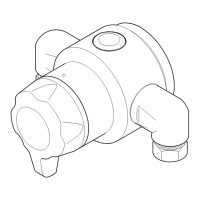11
INSTALLATION
General
Installation must be carried out in accordance with these instructions, and
must be conducted by designated, qualied and competent personnel.
The installation must comply with the “Water Supply (Water Fittings)
Regulations or Scottish Byelaws” or any particular regulations and practices,
specied by the local water company or water undertakers.
1. Before commencing, make sure that the installation conditions comply with
the information given in section: ‘Specications’. For Type 3 valves, see also
installation conditions in the TMV3 Requirements Manual.
2. Care must be taken during installation to prevent any risk of injury or damage.
3. The mixing valve should be positioned for easy access during use and
maintenance. All routine maintenance procedures can be conducted with the
mixing valve body in place (except for strainer and checkvalve access). For all
models, allow a minimum 80 mm clearance in front of the temperature control
to enable removal of the serviceable parts during maintenance. Conveniently
situated isolating valves must be provided for maintenance.
4. The use of supply-line or zone strainers will reduce the need to remove debris at
each mixing valve point. The recommended maximum mesh aperture dimension
for such strainers is 0.5 mm. Inlet pressure tappings which allow measurement
of inlet pressure to the mixing valve under operating conditions are particularly
recommended for healthcare with Type 2 and 3 valves.
5. Pipework must be rigidly supported.
6. Pipework dead-legs should be kept to a minimum. The mixed water outlet piping
should not exceed 2 m and the overall length from the hot water circuit to the
discharge point should not exceed 5 m.
7. Supply pipework layout should be arranged to minimise the effect of other outlet
usage upon the dynamic pressures at the mixing valve inlets.
8. Inlet and outlet threaded joint connections should be made with PTFE tape or
liquid sealant. Do not use oil-based, non-setting jointing compounds.
9. To eliminate pipe debris it is essential that supply pipes are thoroughly ushed
through before connection to the mixing valve.
10. The installation must comply with any particular regulations and practices,
specied by the local water supply regulations.

